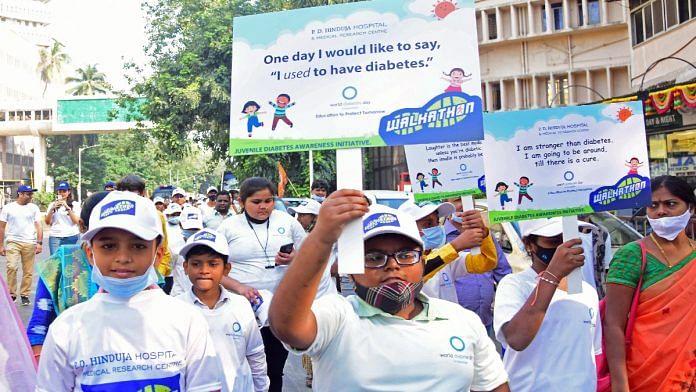New Delhi: A recommendation of the National Institute of Health and Care Excellence (NICE) in the UK could pave the way for juvenile diabetics in that country to be covered for an artificial pancreas under the National Health Service (NHS). Though this expensive device is available in some private facilities in India, work is underway in multiple institutes to devise more pocket-friendly versions.
Juvenile diabetes or type I diabetes is an autoimmune disease where pancreas cells that secrete insulin are destroyed or function at below capacity. It is typically diagnosed in young people.
India is estimated to have three cases of type I diabetes per 1,00,000 children in the 0-14 years age group. Artificial pancreas is an expensive therapeutic option that could cost upward of $5000, according to some estimates, but several Indian institutes are engaged in developing models that could make the treatment affordable.
ThePrint explains the technology and its availability.
Also Read: India accounts for 1 in every 5 cervical cancer cases, almost 1 in 4 deaths, finds Lancet study
Device, not lab-grown organ
The National Institute of Diabetes, Digestive and Kidney Diseases in the US defines an artificial pancreas as one that “automatically monitors your blood glucose level, calculates the amount of insulin you need at different points during the day, and delivers it”.
Artificial pancreas, as the name suggests, is not a lab-grown organ but a device that does the exact function carried out by the islets of Langerhans — the ductless (endocrine) part of the pancreas that produces hormones (including insulin) that are then secreted into the bloodstream.
In a normally functioning pancreas, the islets release insulin to keep the blood sugar level at the optimum range for bodily functions to be carried out.
In patients of type I diabetes, these islet cells are destroyed, often because of an impaired ability of the body to recognise them as its own part so that an immune response is mounted against the cells. At present, the only option available to such patients is to continuously check their blood glucose levels using a monitor (which means they have to prick themselves repeatedly) and then get their insulin, either as a shot (more pricks) or through a pump, which is more expensive.
The artificial version comprises a sensor and a calculator that computes the amount of insulin necessary, besides a pump.
Most artificial pancreas systems require the user to count and enter the amount of carbohydrates consumed at mealtime. These are called “hybrid” artificial pancreas systems because some of the insulin is given automatically and some is given based on the information entered.
These systems help control blood glucose levels throughout the day, making it easier for people with type 1 diabetes to keep their blood glucose level within range.
Keeping blood glucose levels in range can ‘protect type 1 diabetics from developing other health problems and may also improve their daily life’, according to the National Institute of Diabetes and Digestive and Kidney Diseases in the US.
What is the NICE recommendation
The National Institute of Health and Care Excellence (NICE) is the organisation that assesses emerging healthcare technologies and recommends whether they can be used in public health and social programmes in the UK.
A draft guidance from an independent committee that assessed whether artificial pancreas should be recommended for wider use in the UK has now ruled in favour of the device.
In a statement issued Tuesday, NICE said, “NICE has recommended people who are unable to control their condition despite using an insulin pump, or real-time or intermittently scanned continuous glucose monitoring, are offered the technology if their long-term average blood glucose levels are indicating they are at risk of long-term complications. That is, an average HbA1c reading of 8.0% or more when the NICE guideline recommends people should aim for a HbA1c level of 6.5% or lower to minimise the risk of long-term complications from diabetes.”
HbA1c is a measure of how much blood sugar is attached to a Hb (haemoglobin) molecule and is used as a measure of the progression of diabetes.
Availability in India
In India, artificial pancreas as a treatment option for Type I diabetes is still at a nascent stage. In 2021, doctors reported the experience of the first patient in the country to have been fitted with a do-it-yourself artificial pancreas (DIYAP). According to them, the patient reported “better time-in-range, negligible time spent in hypoglycemia, and superior quality of life”.
A DIYAP comprises an insulin pump (often the one currently in use by the patient is re-used), and a continuous glucose monitor. It uses an algorithm to calculate the amount of insulin necessary.
Meanwhile, the Indian Institute of Sciences (IISc) in Bengaluru is working on a project to develop such a device for Indian patients for which a pilot study was conducted last year.
“In a pilot study, the researchers tested their AP system on 10 Type-1 diabetic patients at MS Ramaiah Medical College from January – March 2022 after obtaining clearance from the ethics committee and informed consent from the patients. Out of the 10 subjects, four were successful where the blood glucose was within normal ranges throughout the duration of the trial. Three out of the remaining six were partially successful but were abandoned halfway primarily due to hardware issues,” read a statement issued by the IISc.
(Edited by Amrtansh Arora)
Also Read: Faster healing, less pain: IIT Guwahati researchers create AI tool to predict how fractures heal






